#armagnac-burgundian civil war
Text
Day 5: Isabeau of Bavaria
Isabeau of Bavaria (also spelled Isabelle or Elisabeth)
Born: c. 1370
Died: September 1435
Parents: Stephen III of Bavaria-Ingolstadt and Taddea Visconti of Milan.
Queen of France
Children: Isabella, Queen of England
Joan, Duchess of Brittany
Marie, Prioress of Poissy
Michelle, Duchess of Burgundy
Louis, Dauphin of Viennois
John, Dauphin of Viennois
Catherine, Queen of England
Charles VII of France
Isabeau was the only daughter of Duke Stephen III of Bavaria-Ingolstadt and Taddea Visconti of Milan and granddaughter of the Holy Roman Emperor Louis IV.
Isabeau was sent to France at the suggestion of her uncle to be considered a potential bride for Charles VI of France. The teenaer was prepared by her aunt, taught French customs and received french styled dresses. She went to France on the pretext of a pilgrimage. Her father refused for her to be examined in nude as it was customary at the time.
Upon arriving in France she impressed despite not speaking French or meeting the beauty standards of the time, it is likely she had Italian features like her mother.
Charles seemed smitten with her moving up the wedding.
The two were married in 1285. Isabeau was 15/16 at the time.
Charles lavished her with gifts and visited her at Château de Vincennes where she resided while he was on a military campaign against England.
The coronation of Isabeau took place on 23 August 1389 with a grand ceremony. The procession lasted the whole day.
Charles suffered from an illness that caused him moments of insanity. Often he asked for Isabeau to be removed as he did not recognise her. Isabeau was accused of abandoning him when she moved her residence to Hôtel Barbette. Charles was provided with a mistress by his advisors but in his moment of lucidity he exchanged letters and gifts with Isabeu. His illness continued until his death.
In the 1390s Isabeau was made the guardian of the Dauphin and the co-guardian of their children. She was responsible for the education and protection of their son. As Charles’s bouts of illness were more frequent Isabeau became the leader of the regency council.
As Isabeau sided with the king’s brother, Orléans, in the conflict between him and the burgundians rumors started to circulate that they were lovers. John the Fearless, the new Duke of Burgundy after his father’s death, raised an army and entered Paris. Isabeau and Orléans retreated to the fortified castle of Melun with the royal children, however John took possession of the Dauphin. The Duke of Berry, the Dauphin’s uncle, took control of the child. The fact that Charles was lucid for about a month also helped. Isabeau was tasked with mediating the dispute.
After Orléans' assassination, Isabeau’s concern was the safety of the Dauphin, going as far as to convince Charles to give his 13 year old son power in the absence of the queen. Isabeau created alliances and switched sides in order to protect the heir to the throne.
A double marriage was arranged in 1409 in order to diffuse tensions between burgundians and Orléanists in which Isabeau clearly defined the family hierarchy and her role.
Despite her best effort to stop a civil war, in 1411 the Armagnac–Burgundian Civil War broke out. The dauphin, aged 15, did not have the power or a capable army to defeat John the Fearless. Isabeau allied herself with Charles of Orléans in 1414 instead of allowing her son, aged 18, to lead. The Dauphin changed sides. While the civil war continued, France suffered a blow from England at Agincourt in 1415. The Dauphin died in December 1415 leaving his 17 year old brother and burgundian supporter as heir. In 1417 the new heir died, the new Dauphin aged 14 was Isabeau's last son. He was a sympathizer of the Armagnacs. At the time Isabeau was imprisoned by Armagnac but was freed by the Duke of Burgundy. From that moment she supported the burgundians Treaty of Troyes in 1420.
At first, Isabeau was the sole regent but yielded her position to John the Fearless in January 1418. Together they took control of Paris and slaughtered the Armagnacs. The Dauphin fled the city. John was assassinated in a plot by Dauphin Charles. After the assassination he was disinherited.
By 1419 Henry V of England occupied most of Normandy. In 1420, in the absence of an heir, Isabeau accompanied King Charles to sign the Treaty of Troyes. Due to his illness, Isabeau signed the treaty. Their daughter, Catherine, went on to marry Henry V as part of the agreement.
Isabeau died in late September 1435 in Paris.
The accounts on her appearance are contradictory, some describing her as small and brunette others as tall and blonde. She spoke with a heavy German accent that made her stand out at the French court. She was a skilled diplomat, navigating court politics with ease. She interfed on several occasions on matters of great importance and foreign affairs. She mediated conflicts and was trusted by the king. Like most of the Valois, Isabeau had a fondness for art, loved jewelry and commissioned particularly beautiful pieces. She left many personal possessions and properties, in life and in her will, toNotre Dame, St. Denis, and the convent in Poissy.
Isabeau was close with her children throughout their childhood and even after they were married. She kept them close to her, had them travel with her, bought them gifts and had her daughters educated.
#women in history#women history#french history#bavaria#queen of france#france#catherine of valois#1400s#15th century#medieval history#medieval
4 notes
·
View notes
Note
Now I know about Catherine of Valois's mother. Why is she smeared?
Anon, I'm not going to lie: this ask nearly broke me. To explain why Isabeau of Bavaria was smeared would require me to summarise the entirety of Charles VI of France's reign, from his minority to the factional struggles to his mental illness to Isabeau's role as regent to her role in power struggles to restart of the Hundred Years War to the assassination of Louis, Duke of Orleans and the Armagnac-Burgundian civil war to the Armagnacs' hate-boner for Isabeau to the assassination of Jean the Fearless, Duke of Burgundy to the Treaty of Troyes to Joan of Arc to the Hundred Years War's end and the restoration of French rule. Then, I would probably have to explain how the French revolution further darkened Isabeau's reputation to use as a prototype for Marie-Antoinette and the work historians have done to understand the "truths" of Isabeau's life. As you might imagine, this is a simply enormous, exhausting task. It's also not a subject I feel particularly well-versed to be confident in what I say without doing a ton of re-reading. The thought of all the effort I'd have to go to makes me want to lie down and weep or least seriously consider deleting this blog.
Instead, I recommend you check out Isabeau's wikipedia page for the most basic summary of her life. You can also see the posts I've already made or reblogged about Isabeau on her tag here. If you want specific works about Isabeau, I'd recommend looking at the work of Tracy Adams and Rachel Gibbons in particular. The best are probably Gibbons's "Isabeau of Bavaria, Queen of France (1385-1422): The Creation of an Historical Villainess" and Adams' The Life and Afterlife of Isabeau of Bavaria.
1 note
·
View note
Text
The episode “Darkblade” has D’Argencourt mention an ancestor of his, who bore the Darkblade nickname, and ruled Paris with an iron fist for a while before a wealthy merchant used underhanded means to overthrow him. Can you believe that this is an actual historical event during the Hundred Years War, and this history buff can give you the exact details of what happened?
The historical Darkblade was Bernard VII d’Armagnac, count of Armagnac, relative by marriage of Duke of Orlean Louis I and his successor in leading the Orleanist faction (later renamed Armagnacs) in the civil war against the Burgundians, with the Armagnacs being supported by the French Crown and the Dauphin Charles (future Charles VII) while the Burgundians were supported by the English. This conflict is what brought Bernard to Paris: in 1413 the Burgundians supported the Cabochien Revolt that took over the capital for four months, until the Parisians, having grown weary at the Cabochiens, called the Armagnacs in and joined forces with them to suppress the revolt. For this he was later made Constable of France (commander in chief of the army and highest-ranked noble of France), even as the French army (essentially composed by the Armagnac’s military) was crushed by the English at Agincourt and they and their Burgundian allies started taking over the north of the country. At first the Parisians, remembering what the Burgundians had done, remained on the Crown’s side and beat the Burgundians back when they tried to march on the capital... Then Bernard started ruling Paris with an iron fist, murdering anyone who seemed supporting the Burgundians. Thus a Perrinet Leclerc, alongside the craftsmen and the University of Paris, called the Burgundians in, and on the night of May 29 they let them in before chasing the Armagnacs and the Dauphin Charles out. The Burgundians were quick enough to capture Bernard and a thousand of his supporters to hold them for ransom, but the Parisians found out and on June 12 lynched them all, making clear that if the Burgundians were to rule Paris and then hand it over to the English (as they’d later do) it was only because the Parisians willed it.
As a not-so-funny note, this episode is why the Parisians nearly killed Jeanne d’Arc: she and Charles, now King of France, arrived to retake the capital in 1429 with an army (again mostly Armagnacs) over three times the English garrison and thought they’d have an easy time, but the Parisians, fearing the Armagnacs would try and raze their city, took upon themselves to defend their city, noted Jeanne holding her famed standard and put a crossbow bolt into her, and beat the French army back. They’d later beat back the French army again, and only in 1436 Charles’ troops would re-enter the city... After he had made peace with the Burgundians (bringing them back to his side and ending their feud with the Armagnacs) and promised to respect the privileges of Paris, and after the English garrison begged the French army to be allowed to surrender before the Parisians massacred them all (the Parisians can be terrifying like that).
4 notes
·
View notes
Text
Events 11.4 (before 1940)
1429 – Armagnac–Burgundian Civil War: Joan of Arc liberates Saint-Pierre-le-Moûtier.
1493 – Christopher Columbus reaches Leeward Island and Puerto Rico.
1501 – Catherine of Aragon (later Henry VIII's first wife) meets Arthur Tudor, Henry VIII's older brother – they would later marry.
1576 – Eighty Years' War: In Flanders, Spain captures Antwerp (which is nearly destroyed after three days).
1677 – The future Mary II of England marries William, Prince of Orange; they later jointly reign as William and Mary.
1737 – The Teatro di San Carlo, the oldest working opera house in Europe, is inaugurated in Naples, Italy.
1780 – The Rebellion of Túpac Amaru II against Spanish rule in the Viceroyalty of Peru begins.
1783 – Wolfgang Amadeus Mozart's Symphony No. 36 is performed for the first time in Linz, Austria.
1791 – Northwest Indian War: The Western Confederacy of American Indians wins a major victory over the United States in the Battle of the Wabash.
1798 – The Russo-Ottoman siege of Corfu begins.
1839 – Newport Rising: The last large-scale armed rebellion against authority in mainland Britain.
1847 – Sir James Young Simpson, a Scottish physician, discovers the anaesthetic properties of chloroform.
1852 – Camillo Benso, Count of Cavour, becomes the prime minister of Piedmont-Sardinia, which soon expands to become Italy.
1864 – American Civil War: Confederate troops bombard a Union supply base and destroy millions of dollars in materiel at the Battle of Johnsonville.
1868 – Camagüey, Cuba, revolts against Spain during the Ten Years' War.
1890 – City and South London Railway: London's first deep-level tube railway opens between King William Street and Stockwell.
1918 – World War I: The Armistice of Villa Giusti between Italy and Austria-Hungary is implemented.
1921 – The Saalschutz Abteilung (hall defense detachment) of the Nazi Party is renamed the Sturmabteilung (storm detachment) after a large riot in Munich.
1921 – Japanese Prime Minister Hara Takashi is assassinated in Tokyo.
1922 – In Egypt, British archaeologist Howard Carter and his men find the entrance to Tutankhamun's tomb in the Valley of the Kings.
1924 – Nellie Tayloe Ross of Wyoming becomes the first female elected as governor in the United States.
1936 – Spanish Civil War: Largo Caballero reshuffles his war cabinet, persuading the anarcho-syndicalist CNT to join the government.
1939 – World War II: U.S. President Franklin D. Roosevelt orders the United States Customs Service to implement the Neutrality Act of 1939, allowing cash-and-carry purchases of weapons by belligerents.
0 notes
Text
things were simpler during the armagnac-burgundian civil war
0 notes
Text
Jeanne d arc fate

And what Terry politely calls asking “questions about the world” might more cynically be called Elizabethan ruling-class propaganda. Shakespeare’s three-parter on Henry VI, which gives an account of the later part of the Hundred Years’ War from an English perspective, includes the figure of Joan. More from this author Can you really be non-binary? Her mother Isabelle worked to clear her name in 1456, she was declared a martyr in 1920, she was canonised. She was eventually captured by the English and forced to recant, before changing her mind and proclaiming her beliefs, finally dying on a heretic’s pyre in 1431. Clad in white armour, she helped lead his troops to a number of victories, and marched with Charles through lands held by the hostile Burgundians to his coronation at Reims. Joan, dressed in men’s clothing, was granted an audience with the French King Charles. The broad outlines of what happened next are well-known. That was also when her visions began three years later, she left home under a pretext and travelled to the French King, demanding to see him and offer her aid on the strength of her visions. The year Joan reached puberty, such a band swept through her village of Domrémy, stealing cattle and setting fire to the church. Meanwhile, most actual fighting was done by mercenaries, who prowled the countryside robbing peasants for food, fuel and treasure in lieu of the pay they seldom received. Children would come home bloody from fistfights over competing loyalties to Armagnac king or Burgundian duke. The town across the river from Joan’s birthplace supported the Burgundians, while hers supported the Armagnacs. When Joan was born in 1412, France was roiled by the Hundred Years’ War: a bitter conflict with not only the English fighting for dominion of the country, but a parallel civil war between competing French ruling factions, the Armagnacs and Burgundians. Our writers of today are doing no different.” Shakespeare, Terry says, “did not write historically accurate plays… took figures of the past to ask questions about the world around him. For many in this camp, a “non-binary” reimagining of Joan isn’t “exploring gender”, but “an extension of the dull, patriarchal line that women don’t have a history”.īut it’s also true that - as Globe artistic director Michelle Terry argued in response to the uproar - reimagining and even fabricating history for new audiences is a noble tradition, with Shakespeare himself a leading exponent of the art. One of the largest ever Suffragette marches, comprising some 40,000 women in 1911, was headed by a protestor dressed as Joan. Joan has long been treasured by the women’s movement, as a rare example of a woman who escaped her narrow allotted life and changed the course of history. Today is no exception: she’s causing a furore again, as the central figure in I, Joan, a new play in which she’s represented as “non-binary” and using “they/them” pronouns.įeminists are outraged. During the nearly six centuries since she was burned at the stake, Joan of Arc has been many things to many people. Feminist heroine, Catholic martyr, patron saint of France, LGBTQ icon.

0 notes
Text
The hundred years war
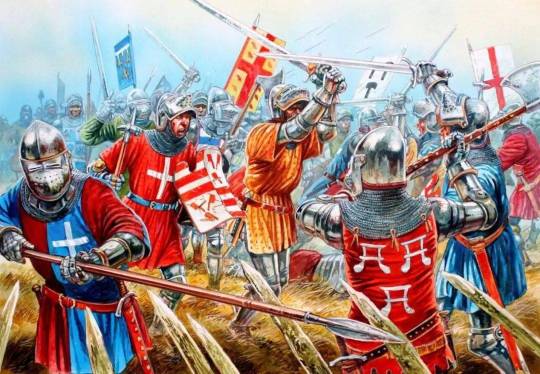
Intro
The Hundred Years War is one of the most famous conflicts of the Middle Ages. It opposes the kings of France of the Valois dynasty to the kings of England for the possession of the kingdom of France.
The conflict can be divided into two periods during which the throne of France is about to fall under English tutelage, before observing an almost total reconquest. In each of these periods, an emblematic figure, a hero, embodies the French upsurge:
The first period of the conflict saw England victorious at Crécy and Poitiers where the King of France was captured. The French surge is made thanks to the constable Bertrand du Guesclin and his king Charles V.
The second period of the conflict saw the birth of a civil war:the Armagnacs against the Burgundians. This fight favors England, victorious at Agincourt. The throne is then promised to the King of England. It is Joan of Arc who will trigger the awakening of the French forces and their race towards victory.
1 note
·
View note
Text
28mm Burgundians: John the Fearless
The Valois duchy of Burgundy is something I always find interesting to study, so painting up some 28mm figures lets me have a bit of a creative outlet for that as well! (although I do find the social and political history more interesting than the military, but that’s neither here nor there!)
From a wargaming perspective, outside of Charles the Bold’s Ordonnances in the 1470s, Burgundy is a bit neglected, and the Armagnac-Burgundian Civil War during John the Fearless’ reign is especially underrepresented in wargaming circles, where it tends to be eclipsed by Agincourt. So with that in mind I set to trying to put together something to represent ol’ Duke John
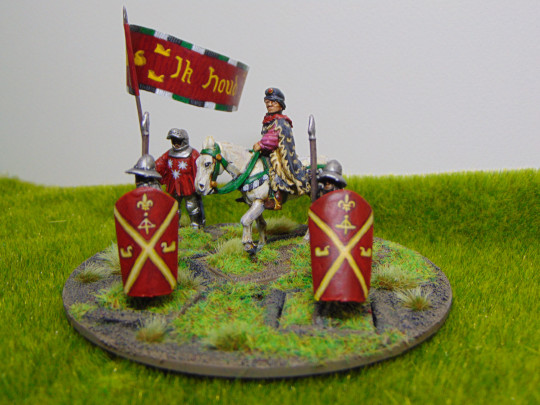
More images and explanations under the cut!

Duke Jean sans Peur himself is based on the Perry Agincourt 'herald' model, who I've chopped and sculpted a bit to get the Duke's distinctive hat and outfit. I've based his colour scheme on miniatures from Pierre Salmon, where he is often shown wearing a big flowing houppelande, in particular at one point he's wearing a black houppelande, heavily embroidered with his personal symbol, the 'rabot.' So I used that example as the basis for my interpretation, complete with the stylish pink sleeves. Meanwhile his horse's saddle and bridle are coloured with his personal colours of black, white and green


Also on the base, the standard bearer is Jacques de Courtiambles, a Burgundian knight, who had fought with Duke (then Count) John at Nicopolis, bore his standard at Othée in 1408, and then continued to serve the duke, and his son into the 1420s. His arms (from what I've found) are three white stars, so I've used those on his houppelande
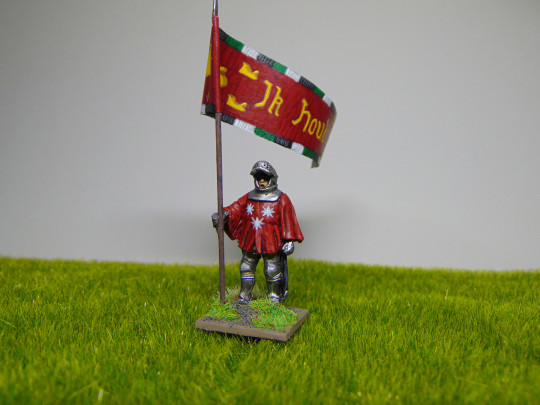
I’ve tried to put together an interpretation of the ducal standard, based on a description of the standard the Duke commissioned in 1406 (and 1418), describing a crimson standard, with a large rabot and a number of smaller rabots embroidered on it. I've also been taking some cues from an Andrey Kurkin illustration. But I've not been able to find a description that includes the Cross of St. Andrew, so I left that out.
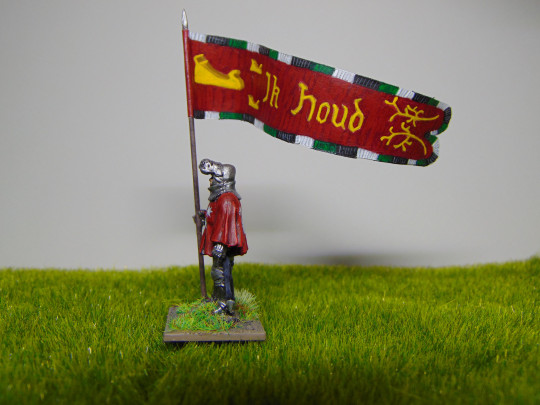
Finally, on the base I've included two pavesiers, in the colours of the ducal guard (again, black, white and light green), however I've not included their "Bundle of arrows" on the sleeve that the ducal archers du corps wore.
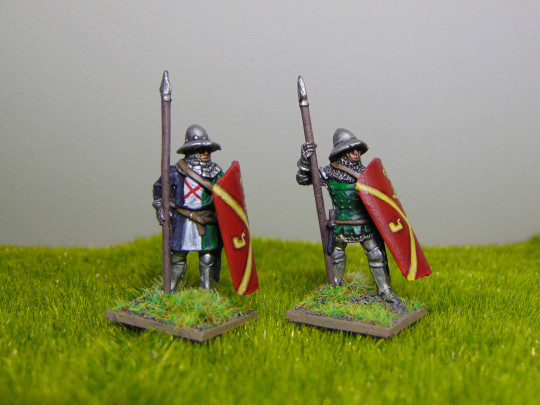
Their pavises are based on contemporary items which include the ducal devise, and also the Cross of St. Andrew, based on a record from 1410 where the Duke orders two pavises "with the devise of the Duke."


I hope the base has turned out ok! I had a lot of fun doing the research and painting it up! The lack of surviving visual clues meant that there’s a lot of room for guess-work and interpretation!
#28mm historical#historical wargaming#john the fearless#jean sans peur#burgundy#valois-burgundy#hundred years war#perry miniatures#armagnac-burgundian civil war#duchy of burgundy#valois-bourgogne#medieval#late medieval
5 notes
·
View notes
Photo



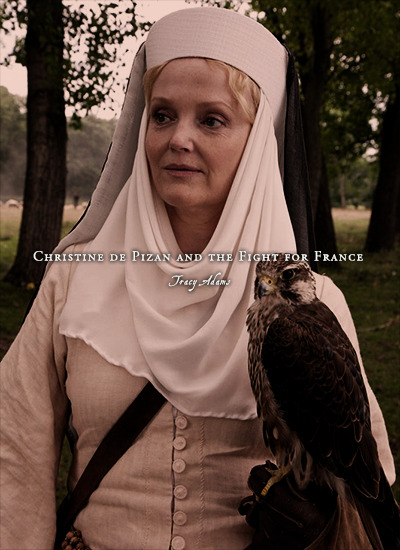
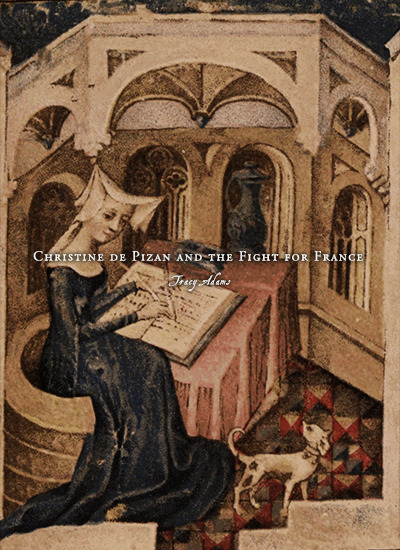

Favorite History Books || Christine de Pizan and the Fight for France by Tracy Adams ★★★★☆
The feud between the Orleanists, or Armagnacs, and Burgundians, that “sickness that so tears through the land” brought on by mad King Charles VI’s inability to reign, is a central theme in Christine de Pizan’s corpus. An observer of the strife, Christine laments the conflict’s devastating material effects on her society throughout her career.
And yet her literary engagement with the feud, her use of “literature as a potent social mediator” to influence the course of the conflict, has received little attention. Although scholars acknowledge Christine de Pizan as one of a group of fifteenth-century political writers to treat “immediate reality and, consequently, what one can call contemporary history,” attention to date has focused more on what she said about women, authorship, and authority, and, in the abstract, kingship, peace, and warfare, than on how she sought to influence her immediate political situation. Scholars who have considered her engagement with contemporary politics have relied heavily on superseded histories, creating a confused narrative of her political loyalties and goals. The poet is depicted as politically neutral (“Christine de Pisan hated factions and had no sympathy for partisan politics”) and/or fickle, switching sides from the Orleanists to the Burgundians and back again. No one disputes that by the second decade of the fifteenth century she was an ardent Armagnac, as the Orleanists were called after 1410, fleeing Paris along with fellow Armagnacs fortunate enough to escape the Burgundian massacre of 1418, and celebrating the triumph of the Armagnac leader King Charles VII in the 1429 Ditié de Jehanne d’Arc . But many scholars place her in the Burgundian camp before this, after a still earlier flirtation with the Orleanists. This narrative has her soliciting the patronage of the brother of the mad king, Louis, Duke of Orleans, regent during the king’s episodes of insanity, but, irritated by a slight (Louis is supposed to have refused to find a place for her son in his household) and disillusioned with his profligacy, she abandons him to become a discreet propagandist for the king’s uncle, Philippe of Burgundy. Although some believe that she was less enthusiastic about Philip’s successor, the notion that after Jean sans Peur (the Fearless) succeeded his father as Duke of Burgundy in 1404, Christine remained in her “secure seat in the Burgundian camp” as a “paid Burgundian propagandist” continues to hold force. The most widely read biography of the poet in English reports the presumed shifts of allegiance without comment, slipping in the space of one paragraph from “Christine had enjoyed the patronage of two dukes of Burgundy,” to “her son was now one of the dauphin’s [the future Charles VII’s] secretaries,” to Christine’s “family was fortunate to escape [the Burgundian massacre] with their lives.”
The incoherence results from a narrative of political activity at Charles VI’s court developed by historians influenced by the ideals of the French Revolution, a narrative itself derived from Burgundian propaganda circulated after Jean of Burgundy’s assassination of the Duke of Orleans in 1407. Republicans like Louise de Kéralio uncritically adopted Burgundian images of the king’s brother and the queen as greedy wastrels, and that of the dukes of Burgundy as men of the people. In her 1791 diatribe on the queens of France, Kéralio paints Queen Isabeau as an early Marie Antoinette and Louis as the Count of Artois. This narrative passed into the works of nineteenth century historians: Michelet, Guizot, Martin, Coville, and Thibault reinforced the pair’s negative reputation. True, monarchist historians viewed Louis positively (although they were less favorable toward Isabeau), but they were few in number compared to their Republican counterparts.
The 1838 essay by Raimond Thomassy, an early scholar of Christine’s political thought, manifests these Burgundian biases. Thomassy writes of Louis of Orleans that, “as brother of the king, he claimed to be invested with principal authority to govern during the illness of Charles VI,” as if the duke had no legitimate claim to regency. Moreover, Thomassy asserts that Louis “destroyed the people with exactions, dilapidated without shame the public treasury,” without mentioning that the taxes were for the war with England or that such complaints were routinely leveled for political reasons against anyone possessing the right to tax. By contrast, Thomassy describes Philippe as the “heir in wisdom and determination of Charles V.” As for Isabeau of Bavaria, the odious queen “brought shame and infamy to sit on the throne of France and betrayed at the same time her feminine, maternal, and wifely duties.” Nor is it widely understood that the assumption that the queen suffered from a bad reputation during her lifetime is based on four unflattering comments in the chronicle of Michel Pintoin, the Burgundian-biased monk of Saint Denis, all from the same year in which Jean of Burgundy first tried to seize control of the mad king. And it is rarely acknowledged that evidence for the unpopularity of Louis of Orleans comes primarily from the same source, along with another anti-Orleanist chronicle, that of Pierre Cochon, and the justification of Louis’s assassination pronounced by Jean Petit on behalf of Jean of Burgundy. Even recent Christine scholarship continues to show the influence of the Burgundian narrative, drawing an equivalency between Louis’s regency claim and the attempts of the dukes of Burgundy to seize control of the government, seeing both as the “usurpation of power by the king’s brother, uncles and nephews.” About Christine’s view of the Duke of Orleans, we read that it is “evident that she wanted [him] in particular to take heed” of her writings on prudence. Philippe of Burgundy, by contrast, was “an effective diplomat as well as a sound military adviser,” and, more important, functioned as “a moderating force in the polemical atmosphere of the court.” Isabeau, Charles VI’s “beautiful, sluttish wife,” “encouraged” him “in his taste for pleasure.” King Charles VI is imagined to have been reduced to rags while his family members pillaged the treasury to support their own luxurious lifestyles; gossip circulated about “the relations between the queen and the duke of Orleans, a liaison that lasted until the duke’s assassination in a Paris street near the queen’s residence in November 1407.”
This study rereads Christine’s major works from a perspective informed by recent historical scholarship on the Armagnac-Burgundian feud. Because the views of Burgundian chroniclers represent just one of several contemporary feud narratives, I widen the set of documents generally relied on to reconstruct Christine’s historico-political context. My argument, laid out in the following chapters, is that when Christine’s works are reread within this broader context— that is, when the Burgundian images of Louis, Isabeau, and Philippe are recognized as propaganda and supplemented with other sources— it becomes clear that the poet’s many narrative voices consistently support the Orleanists. She is of necessity discreet, but she does indeed “challenge the particular interests of the princes,” at least the Burgundian princes. Such a claim requires untangling two frequently confounded perspectives on the poet’s political interactions: first, her beliefs about regency, which follow from her view of kingship, and second, her interactions and personal friendships with noble patrons. Flattery of Philippe of Burgundy has often been assumed to be tantamount to promoting his regency claim. As I hope to show, however, Christine’s conception of regency was motivated by principles that remained steadfast throughout her career.
#historyedit#litedit#christine de pizan#medieval#french history#european history#women's history#history#history books#nanshe's graphics#armagnac burgundian civil war#hundred years' war
60 notes
·
View notes
Text
Ikemen Vampire - Jean d’Arc Route Summary Chapter 10
here is the tenth chapter!
to clarify again, I’m not very good at japanese so if anything is wrong or weirdly translated everything is on me.
of course there is going to be some spoilers so do not read if you don’t wish to know jean’s story yet.
*also little bonus at the end about Jeanne d’Arc real story! of course you don’t have to read it to understand his route in the game but it’s very interesting :)*

The Count tells MC the history of the war between France and England, also known as the Hundred Years’ War...

【 Comte 】 Jean was a soldier who led the French army during the Hundred Years War.
Jean fights for his country, France and defeats the English army. Jean d’Arc, soon after the defeat of the enemy, becomes a true hero for his people.
However, such glory won’t last for Jean :(
'The most tragic end of the world's heroes', as they say.
In the course of the battle, Jean was captured as a prisoner of war by the enemy. The King didn’t want to help him for some reason. 😡
And of course... 🙄
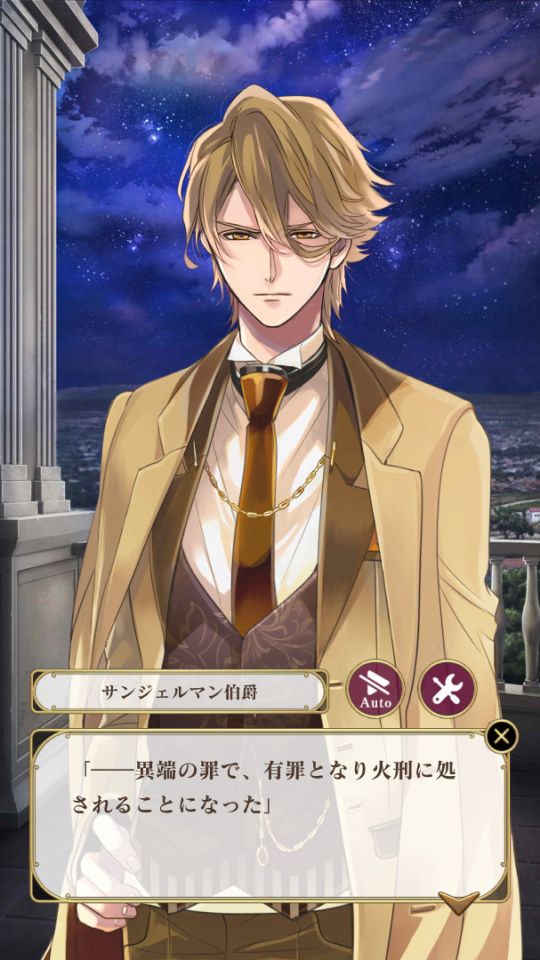
【 Comte 】 Jean was convicted of heresy and it has been decided that he would be sentenced to fire.
After Jean's death, the king ordered a re-examination of his treason and found him to be innocent, and he went down as a hero of France.
The fact that Jean never knew went down as a hero after his death and this won’t change the fact that he died as an innocent. The protagonist is angry because it doesn't make any sense.

From the bottom of my stomach, I feel a mixture of anger and frustration.
Here, the MC asks the Count a question.
“Why did he bring him back to life after such a death?”
There's something different about the Count returning the great men of the mansion and Jean.
The MC wonders if Jean really wanted the Count to bring him back to life.
Before the Count can answer, Jean appears, interrupts him, takes the MC by the arm and leads her away.

【 Jean 】 One look at this man's face is enough. I don't like it. Let's go, woman.
As soon as they arrived in the library, Jean seems to have calmed down a little lets go of the MC's arm.
The protagonist apologises for trying to find out about his past without his permission, but Jean says that's okay. Jean says it's okay, because his life has been written about in books anyway.
However, he says that he doesn't want the Count to tell her about it.

【 Jean 】 ...It's not enough to say I hate it, it's too much.
Jean says that he is not a hero and that he is no different from the children's book he used to read, The Ugly Duckling.
it hurts me so much that this is the way he perceives himself when he deserves all the love in the world </3

Jean's gaze fell on the book 'The Ugly Duckling', which was still on the table.
That’s it for chapter 10!

here is some real background info about the real Jeanne d’Arc! She is such a brave and interesting historical figure. The epitome of a real badass, fearless and powerful woman.
so, the hundred years' war, if we summarize as much as possible is a series of armed conflicts that began in 1337. which opposes the kingdom of france and the kingdom of england.
in 1328 at the death of king charles iv, the question arises as to who will inherit the french crown.
one then has the choice between the cousin of the preceding king philippe de valois and edward iii the king of england who by his mother isabelle is also a descendant of the french throne.
you can imagine putting an english king on the french throne, wasn’t seen very well.
edward not happy, which led to a succession crisis, which lead to the hundred years' war.
obviously this conflict, quickly overcomes a simple succession crisis.
it's a mess.
what you have to remember, is that the english are gradually invading part of the kingdom of france.
in 1415, after the battle of azincourt and the english victory, the english king henry v controls much of the north of the kingdom of france, including paris for that matter.
but it is far from being the only concern.
what you have to keep in mind is that the king of france at the time, charles vi, is reached at rather regular intervals of madness.
this obviously prevents him from administering the kingdom properly.
as a result, in parallel with the conflict with the english, a real civil war breaks out.
to find out who between his son the heir charles and his cousin the duke of burgundy will be able to take back the reins of the kingdom; the duke of burgundy is supported by the burgundians who will end up allying themselves with the english and the son of the king the heir charles is supported by the armagnacs.
but during this time, charles is betrayed by his own father who disinherits his son and after his death, gives the crown to the english.
i warned you that it was really messy.
and it is in this incredible mess that our jeanne arrives.
and where exactly does jeanne come from? from domremy.
she is also often called the virgin of orleans.
she is associated with the city of reims, but jeanne was originally born in domremy.
and where exactly is this place? domremy is this little town to the west of the city of the vosges department, on the banks of the meuse river.

isn't it pretty?


this is jeanne's birth house,
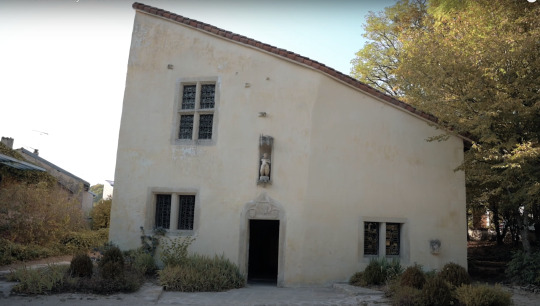
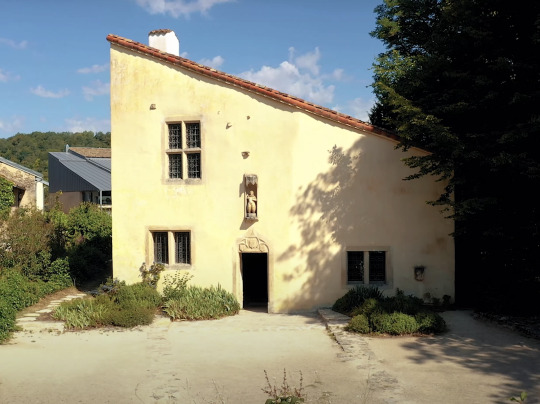
she would have been born around 1412. the building classified as a historical monument since 1840 includes in addition to a cellar, three large rooms originally used to house the whole family, her parents and four siblings.
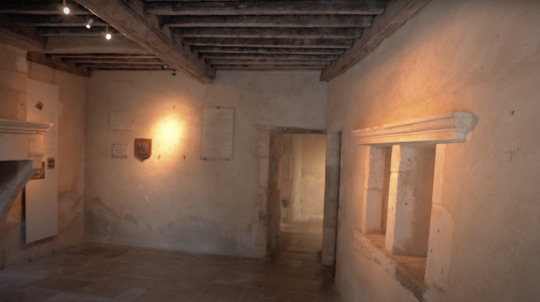
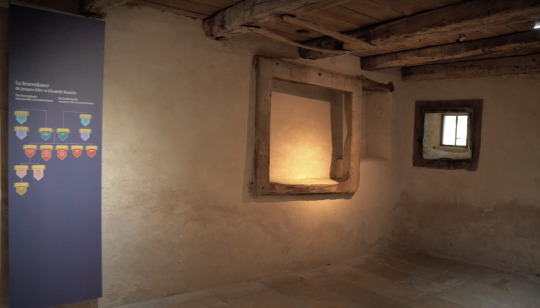
according to jeanne's trial, it is here that she would have learned to sew or weave which were two occupations of the young girls of the time.
her father was a ploughman, so she often had to look after the animals.
and since she is very pious she spent a lot of time praying.
she went on pilgrimage at least once a week, for example in the notre dame de bermont chapel, about three kilometres (as the crow flies) from her birth house.
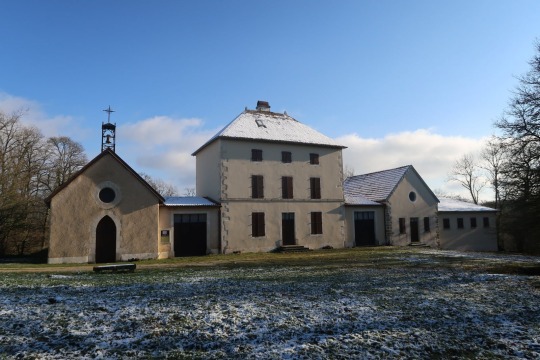
and jeanne d’arc, as you may have guessed, wasn't always called jeanne d’arc.
no, in history she has had different names and official nicknames.
there are of course the best known ones: the virgin of orleans, jeanne the virgin or even just the virgin and in the vicinity of domremy she was also called the jeannette de rommée, in connection with her mother's name. she has even signed several letters with the name jehanne.
and it's even more complicated if you're interested in her surname “d'arc”.
which was originally written darc, without the apostrophe. here again there have been many variations, and i'll mention a few of them: tarc, dars, darx and even d'ailly or daly according to the phonetic transcription of her name, with a lorraine accent. from there we move on to duly, then du lys.
when the king ennobled jeanne and her family, it is written on the deed, la dame du lys in reference to the royal coat of arms.
this is the magnificent bois-chenu basilica, which was built between 1880 and 1940 in honour of jeanne.

and for the record, this incredible basilica was sometimes considered to be the place where jeanne would have heard voices.
however if we refer to the trial, it is in her father's garden, near the house, that jeanne would have started hearing voices, celestial calls, coming from saint catherine of st. margaret's and the archangel saint michael.
the divine mission entrusted to her was very “simple”.
she was only commanded to be a cavalier, to cross a kingdom occupied by the english to go and find the future charles vii and convince him that she is the one sent from heaven.
to help him to take his place on the throne by her coronation in reims.
to show him how to liberate the kingdom of france, of the english presence.
it seems to be an easy enough mission for me. 😅 (nope)
so obviously you can imagine that the people didn't take her seriously right away. it took a few years before she managed to convince the world that she wasn't completely crazy.
- jeanne?
- yes?
- this is the voice.
- is someone talking to me?
- you are the chosen one, jeanne, join me.
- yes, i'm coming.
- i hope you like human barbecue. (ok i'll stop :/)
how is the legend of jeanne forged? how does one go from being a peasant girl eager to help, to jeanne of arc, heroine of the kingdom of france?
this is le centre d’interprétation (the interpretation centre), which is just behind jeanne of arc's birth house and retraces her youth and adventures.


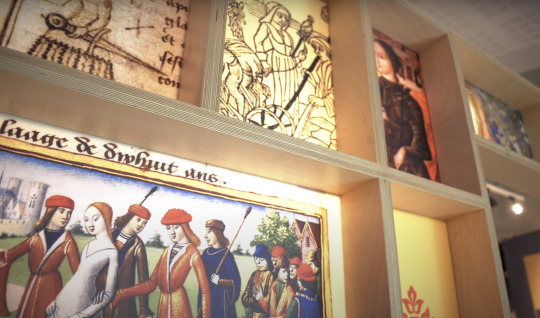
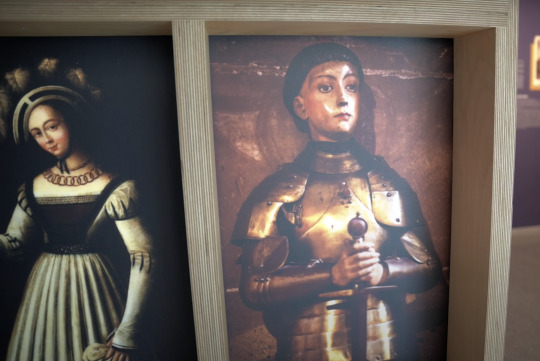

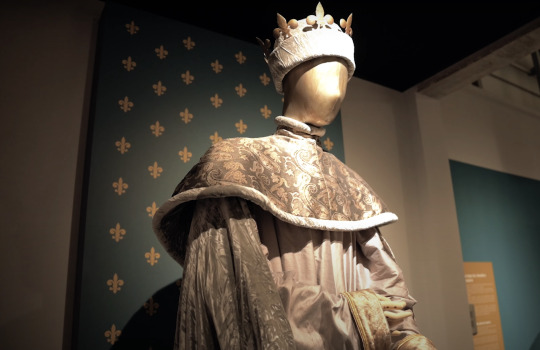
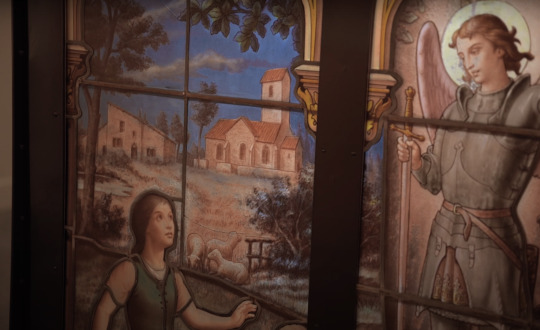



her journey is incredible, at 17 years old, jeanne can't stand not doing anything anymore, she has been hearing voices urging her to act for four years now.
so she decides to return to the ch��tellenie de vaucouleurs, to meet captain robert de baudricourt, one of the king's faithful followers and after several vicissitudes, she manages to convince him. it wasn't easy, i remind you that her main point was that she hears voices. but yeah, he finally agrees to send her with an escort, join the heirn in chinon.
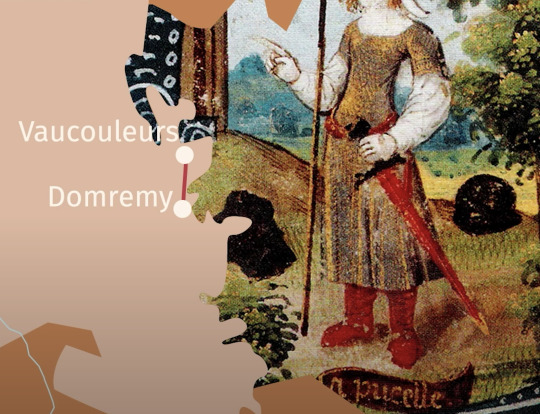
the journey is quite long and above all risky, we are talking about more than 500 kilometres and in this period of turmoil, the dangers were quite present especially if you look at the map, one realizes that the small expedition crosses areas not controlled by the enemy coalition.
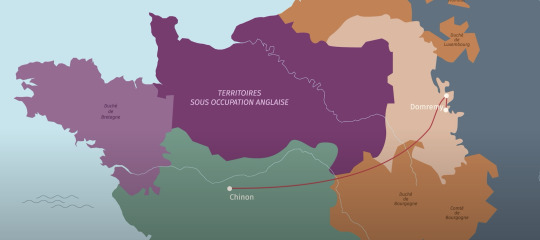
fortunately, everything went well for jeanne, who arrives at her destination on march 1429 and gets an audience with the heir two days later. he was quite suspicious of this young woman at first, who claims to hear divine voices but according to the story she made a revelation to him that we don't know which eventually convinced him.
for the entourage of the suitor of the throne, it's not that simple and you can understand them, betting on jeanne is a little bit like a poker game. so they insist that she will be given a few interrogations, she is questioned about her life, about her morals and finally confidence is established, she is equipped with military equipment. she then undergoes mini combat trainings and here we go, her dream is about to come true, she joins a supply convoy in blois and on april 22nd, with more than 4000 men, she is headed for orléans.
the arrival of jeanne of arc changes many things.
her faith, her confidence in victory gives hope to the soldiers and to the inhabitants, who are filled with new energy. they manage to win in less than 10 days, 10 days and the english are obliged to give up their plan, which consisted of taking the city and then attacking the south of the loire.
jeanne who comes out of this battle with this image as a victorious, ultra badass woman and just earned her nickname... la pucelle d'orléans (the virgin of orleans).
thanks to her victory in orleans, jeanne thus becomes a kind of national heroine. she represents by her fame and her qualities, a not insignificant asset for the heir in his fight against the english and the burgundians.
but what makes a real difference is less her qualities as a war strategist and more her ability to charm and to galvanise the troops and the inhabitants along the way.
it's quite simple, before jeanne's arrival, the english had a reputation for never losing their invincibility.
and jeanne achieves the feat of restoring confidence in a possible victory.
it gives the impression to the troops that they are going to receive a kind of divine help and it changes everything in the soldiers' minds, all the more so because before her arrival there was a prophecy, who said that a virgin would help defeat the english so when jeanne arrives, everyone thought "it's ok, we're saved"!
jeanne persuades the future king to start a ride to reims who is in the middle of enemy territory, to be crowned.
jeanne thus succeeded in carrying out one of the following missions which were supposedly entrusted to her by the voices she hears; in other words, since she has succeeded, she is necessarily an envoy of god, and that for the mood of the troops, it makes a huge difference.
unfortunately after the time of victories comes the time of defeats.
after the coronation, the king and jeanne no longer really agree. she is convinced that her mission is to keep the english out of france.
the king, for his part, is longing for a little rest.
for example, he does not feel at all capable of taking back paris, while jeanne, a little bit stubborn, goes there anyway and suffers a failure.
on top of that she is wounded, she gets a crossbow arrow in her thigh, moreover, she breaks her sword which had for all victories...
it's a bad sign.
some people think that the virgin is abandoned by god. some time later jeanne went to compiègne, a city besieged by the burgundians and by some english contingents and once again it goes wrong, she is taken prisoner in may 1430, by the burgundians.
she tried to escape, but all her attempts failed and in november of the same year, she was sold to the english. jeanne is then taken to the castle of rouen, where members of the church judge her for heresy.
the trial was to say that charles vii was crowned thanks to a witch, she is also blamed for everything and anything, for dressing in men's clothing,
for deferring directly to god's judgement without going through the church, for hearing the voices of demons and not of saints.
jeanne really plays her life on each of her answers, in addition, she faces accusers totally committed to the english cause on her own when she was only 19 years old.
moreover, the witnesses are obviously not chosen at random, everyone who could speak up for jeanne is under pressure. everything is being done to ensure that she is condemned. finally, she ends up at the stake, on the market square, and we make sure there's nothing left of her body, to prevent it from being turned into holy relics.
and then after the end of the hundred years' war, i.e. almost 25 years later, the church reverses this first court decision. king charles vii wants to wash away the insult that was done to him through this trial and he pushes jeanne's family to ask for a review. pope calixtus iii agreed and jeanne was rehabilitated in 1456. the investigations carried out are more serious, many of jeanne's contemporaries jostle to plead in her favour and even people who had once spoken badly of her finally return to saying good things about her.
the first judgement is broken and the young woman's memory is rehabilitated.
an unusual little fact in the end - many people have not been able to admit that the story of the virgin ends up on a pyre. for them it was impossible, this story was too beautiful, this too extraordinary woman.
and it went far enough that people found stories of women, who a few years later claimed to be the real jeanne.
just imagine them saying stuff like "oh yeah, yeah it's me i didn't burn at all, my face has changed a little bit but it's me, i assure you, believe me, really".
a certain claude des armoises is said to have pretended to be her, in the metz region. after having acquired a certain renown, having been given gifts by former relatives of jeanne; she even went so far as to meet two of the virgin's brothers, who (hold on because it's completely insane) believed her.
they really believed it was their own sister who had died at the stake.
it's a crazy story!
well, we don't really know if they really believed it, or if one pretends to believe it for financial reasons for example.
in any case, this woman, who was talked about everywhere, is unmasked by the king himself, so that this fraud can be stopped.
in the end, i find this story quite unusual.
here are the friends!
i hope it wasn’t too long to read (it probably was) and that you have learned two, three little things on our dear jeanne d’arc. after all, she is one of the most famous women in history!

#ikemen#ikemen games#ikemen series#ikemen spoilers#Ikemen Vampire#ikemen jean#IkeVamp#ikevamp jean#Jean#Jean D'arc#jean route#ikemen vampire jean#jeanne d'arc#history#france#my translation#jean all chapters
59 notes
·
View notes
Photo
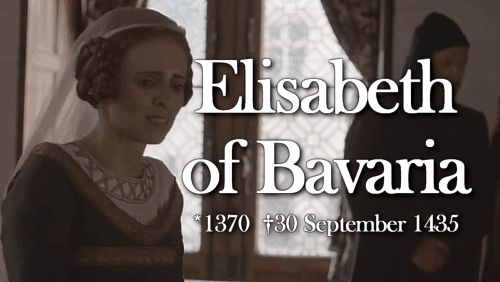

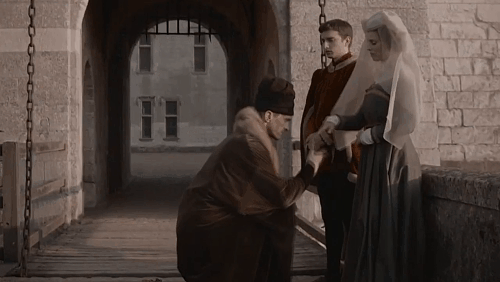
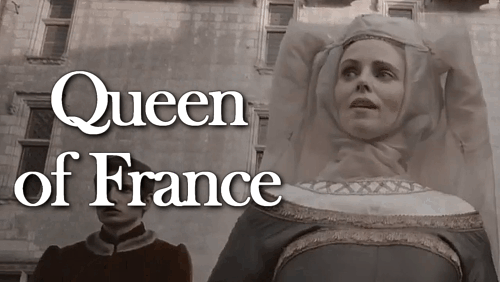




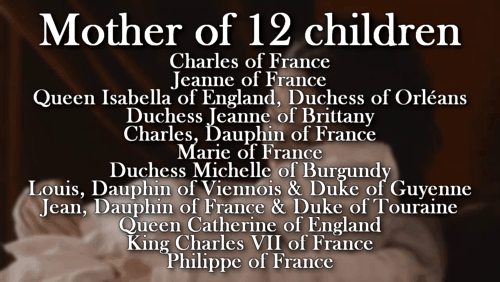
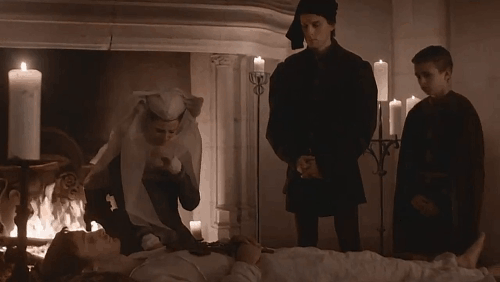
House of Wittelsbach & of Valois: Elisabeth or Isabeau of Bavaria
Elisabeth was born as the second child to Duke Stephen III of Bavaria(-Ingolstadt) and his first wife Taddea Visconti. Her older brother was Duke Louis VII of Bavaria. Elisabeth is often referred to by the French version of her name Isabeau as well as Isabelle.
Elisabeth’s uncle Duke Frederick of Bavaria suggested her as French queen consort when she was only 13. At the double wedding of John the Fearless and Margaret of Burgundy to Margaret of Bavaria and Duke William II of Bavaria-Straubing two years later, he proposed this idea again. Her future husband Charles was riding at the tournament that day. Reluctantly Elisabeth’s father agreed to send her to France to be examined as a potential bride but demanded that her uncle and brother who accompanied her would not tell her the purpose of the journey.
Charles and Elisabeth married only three days after they were presented to one another. He apparently had fallen in love with her as he continued to give her lavish gifts in the coming years. But first the couple was seperated once again as Charles had to go on campaign while Elisabeth would stay with his step great-grandmother Blanche of Navarre who taught her French etiquette.
The marriage resulted in twelve children. Many of them died young but some are famous until this day, like the English queens Isabella and Catherine of Valois as well as of cours King Charles VII of France.
Seven years after their wedding, Charles mental illness began to show. In 1393, he was declared unfit to rule and a regency council was established. Elisabeth became the head of it. This council would soon lead to a civil war between the factions of Armagnac and Burgundy whose duke’s were fighting over influence and positions at court.
After the death of his older brothers, Charles became The Dauphin of France. But he and his mother despised one another. He disagreed with her lifestyle and even thought her to have extramarital affairs. Because of this Charles’ expelled her from court. This turned Elisabeth to side of the Burgundians and she began her fight against his rule. Even claiming him to be a bastard since she no longer had to fear repurcussions. Her husband was too mad to act and the Burgundians were her allies.
Elisabeth supported her English son-in-law Henry V heir to the French throne. But Henry died in 1422, when his son Henry VI was only an infant. Only a few weeks later Elisabeth’s husband died too. She was now alone without any allies. Her final decision was to go into exile in Burgundy.
Elisabeth died on September 30th, 1435. She was buried at the Basilia of Saint-Denis in Paris until the royal tombs were scaveged during the French Revolution on October 17th, 1793. She is now buried in a mass grave outside the church.
// Catherine Zavlav as Isabeau de Bavière in The Real War of Thrones
#period drama#perioddramaedit#women in history#1400s#15th century#Elisabeth of Bavaria#Isabeau of Bavaria#Queen Isabeau of France#House of Wittelsbach#House of Valois#French history#German history#European history#Isabeau de Bavière#The Real War of Thrones#queen of france
219 notes
·
View notes
Note
If England had won the hundred years war and kept (or even expanded) their French possessions, would the War of the Roses still have kicked off?
I’m skeptical that England could have won the Hundred Years War in the long run. Even leaving aside the basic problem of growing nationalism on both sides that I think would ultimately fatally undermine English rule in France no matter what, the English position was precarious at best.
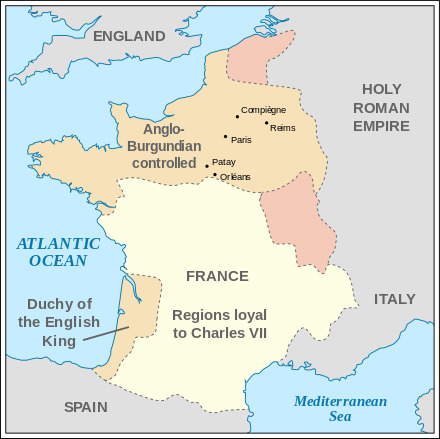
This map above is how things stood in 1428, shortly before Jean d’Arc transformed French fortunes. To begin with, you have the problem that the English position is stretched out and non-contiguous, which makes it extremely difficult to hang on to the very wealthy Duchy of Aquitaine, surrounded on three sides by French territory. Even its more compact northern holdings are wider than they are deep and potentially can be split off - say by a French drive to separate Brittany from Normandy - and are reliant on support from Burgundy (the pink sections on the map).
If Burgundy switches sides, all of the sudden the English position at Paris et al. is suddenly menaced on two fronts. The problem is that the Burgundians have split motives - on the one hand, they want more independence from France and revenge against the Dauphin for assassinating Duke John the Fearless, but on the other hand, they want Charles VII to stop backing the Armagnac in the ongoing Burgundian Civil War which was a satellite conflict of the Hundred Years War.
22 notes
·
View notes
Text
Events 11.2 (before 1960)
619 – A qaghan of the Western Turkic Khaganate is assassinated in a Chinese palace by Eastern Turkic rivals after the approval of Tang emperor Gaozu.
1410 – The Peace of Bicêtre suspends hostilities in the Armagnac–Burgundian Civil War.
1675 – Plymouth Colony governor Josiah Winslow leads a colonial militia against the Narragansett during King Philip's War.
1795 – The French Directory, a five-man revolutionary government, is created.
1868 – Time zone: New Zealand officially adopts a standard time to be observed nationally.
1882 – The great fire destroys a large part of Oulu's city center in Oulu Province, Finland.
1889 – North Dakota and South Dakota are admitted as the 39th and 40th U.S. states.
1899 – The Boers begin their 118-day siege of British-held Ladysmith during the Second Boer War.
1912 – Bulgaria defeats the Ottoman Empire in the Battle of Lule Burgas, the bloodiest battle of the First Balkan War, which opens her way to Constantinople.
1914 – World War I: The Russian Empire declares war on the Ottoman Empire and the Dardanelles is subsequently closed.
1917 – The Balfour Declaration proclaims British support for the "establishment in Palestine of a national home for the Jewish people" with the clear understanding "that nothing shall be done which may prejudice the civil and religious rights of existing non-Jewish communities".
1917 – The Military Revolutionary Committee of the Petrograd Soviet, in charge of preparation and carrying out the Russian Revolution, holds its first meeting.
1920 – In the United States, KDKA of Pittsburgh starts broadcasting as the first commercial radio station. The first broadcast is the result of the 1920 United States presidential election.
1936 – The British Broadcasting Corporation initiates the BBC Television Service, the world's first regular, "high-definition" (then defined as at least 200 lines) service. Renamed BBC1 in 1964, the channel still runs to this day.
1940 – World War II: First day of Battle of Elaia–Kalamas between the Greeks and the Italians.
1947 – In California, designer Howard Hughes performs the maiden (and only) flight of the Hughes H-4 Hercules (also known as the "Spruce Goose"), the largest fixed-wing aircraft ever built until Scaled Composites rolled out their Stratolaunch in May 2017.
1949 – The Dutch–Indonesian Round Table Conference ends with the Netherlands agreeing to transfer sovereignty of the Dutch East Indies to the United States of Indonesia.
1951 – Canada in the Korean War: A platoon of The Royal Canadian Regiment defends a vital area against a full battalion of Chinese troops in the Battle of the Song-gok Spur. The engagement lasts into the early hours the next day.
1956 – Hungarian Revolution: Nikita Khrushchev meets with leaders of other Communist countries to seek their advice on the situation in Hungary, selecting János Kádár as the country's next leader on the advice of Josip Broz Tito.
1956 – Suez Crisis: Israel occupies the Gaza Strip.
1959 – Quiz show scandals: Twenty-One game show contestant Charles Van Doren admits to a Congressional committee that he had been given questions and answers in advance.
1959 – The first section of the M1 motorway, the first inter-urban motorway in the United Kingdom, is opened between the present junctions 5 and 18, along with the M10 motorway and M45 motorway.
1 note
·
View note
Photo
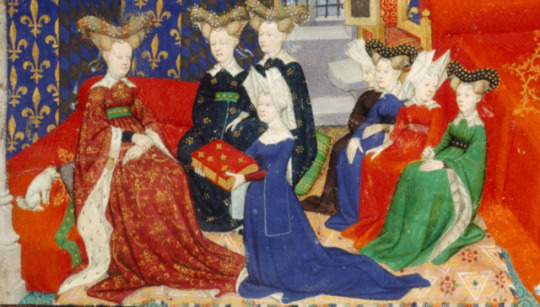
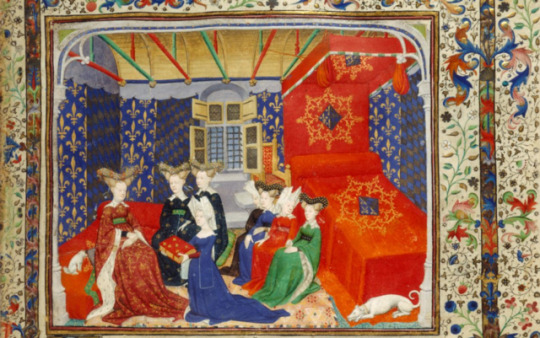
A Woman’s Affair: Christine and Isabeau
From the Book of the Queen, a collection of works by Christine de Pizan presented to Queen Isabeau of Bavaria
in London: British Library, Harley ms. 4431, f.3r (Paris, ca. 1410-1414)
Isabeau of Bavaria, a German aristocrat, became Queen of France when she married the young king Charles VI in 1385 (she was 14, he 17). She played a major role in French politics, trying to keep the peace between the opposing factions leaded by the houses of Burgundy and Orleans-Armagnac. When the civil war finally broke out, she initially supported the Armagnacs, but later on she sided with the Burgundians and agreed to the Treaty of Troyes (1420), which recognized English king Henry V as heir to the French crown in place of dauphin Charles, who was formally disinherited and banished from the kingdom of France as a result of his crimes.
Isabeau was a refined patron of the arts, and she provided patronage to one of the most important female writers of medieval Europe: Christine de Pizan.
Her longstanding reputation as a villainess is little more than political propaganda against a powerful woman, whose husband’s mental illness enabled her to act as regent, and whose accordance with the Anglo-Burgundian regime established at Troyes eventually placed her on the losing side of history.
#history #art #illuminated manuscripts #medieval #medievaltumblr #medievalart #medievaltimes #womenhistory #medievalwomen #medievalworld #herstory
#
1 note
·
View note
Photo
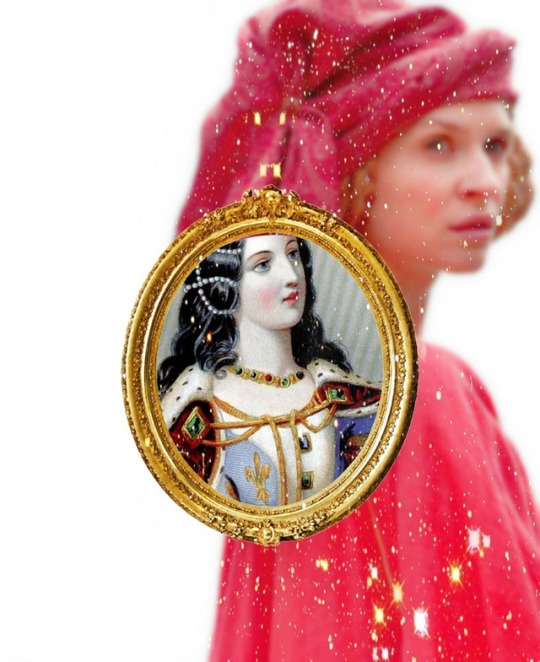
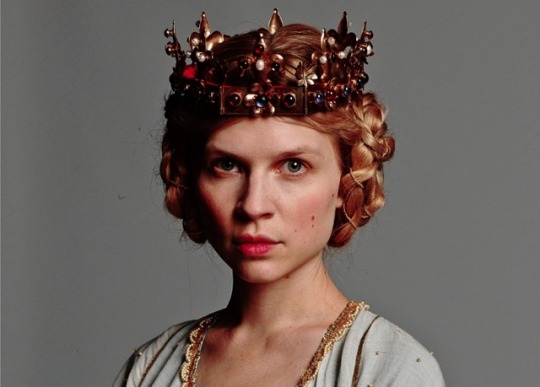
Today in history - The death of Isabella of Valois
On June 29, 1406, Isabelle married her first cousin, the eldest son and heir of her uncle, the Duke of Orleans. Based mainly in Blois, she was witness to the growing strife of her family, particularly when her father-in-law was murdered on the orders of Burgundy in November 1407. Siding with her in-laws, she was estranged from her parents who pardoned Burgundy out of necessity until a peace was reached at Chartres in March 1409. By then Isabelle was pregnant with her first child. She gave birth to a daughter, Jeanne, on September and died a few days later on the 13th. She was only 19 years old.
Her second husband, Charles, Duke of Orleans, became a leader of one faction in the ongoing Burgundian-Armagnac civil war. He made a deal with Henry IV’s government in England in 1412/1413 in the hopes of using them to permanently oust Burgundy, however Henry IV’s death in 1413 and Henry V’s accession helped fast-track England’s invasion. He fought at the Battle of Agincourt in October 1415 and was captured. He remained a prisoner in England until his release in 1440.
Her daughter, Jeanne, married Jean, Duke of Alencon in 1424. She died, childless, in 1432.
Isabelle’s younger sister, Katherine, born after Isabelle’s marriage to Richard and raised in the convent of Poissy, married Henry V in 1420 and was the mother of Henry VI. After her husband’s death in 1422 she married Owen Tudor, eventually becoming the grandmother and great-grandmother of Henry VII and Henry VIII.
30 notes
·
View notes
Photo

@cornbreadcrumbs @malvoliowithin put the major problem with Dan Jones better here than I did. It's not simplification, it's that he has some gross attitudes that I can't excuse. I'd be less against him were he not so homophobic and ableist (and were more impartial). My hope as a historian and a history teacher of some kind is people will get the best history regardless of source, but simplification is one thing and the way he does it is another entirely. I don't know about his books but in his show on the Plantagenets he was pretty insensitive on Edward II's death and how it was "too good a story" and fitting, and with Henry VI he didn't just say Henry's mental illness contributed to his bad reign, he makes the connection that because he was a bad king, he was a bad person. That's the ableism. It's not inherently ableist to say his later illness was part of his bad reign, but to say he was the "villian" of the Wars of the Roses the way he puts it is. It's like saying Charles VI was the villian of the Burgundian-Armagnac Civil War. And these are outdated, shitty things to say that proper historians reject. And they're the last thing queer and disabled people, whether casually or seriously into the topic need to see. That all makes me less inclined to like his general facts. There's always going to be bias in writing history-- I'd probably come off as thirsty for Richard II lol, and I'm certainly sympathetic to the Orleanist/Armagnac faction (except for Armagnac himself...) And I'm really anti-Vietnam War, so that would be my biases I'd have, but his biases are homophobic and ableist, which skews his presentation of some topics, at least in his show, and don't need to be continued. And History Channel... after that article on Charles I can't trust you farther than I can throw you.
5 notes
·
View notes